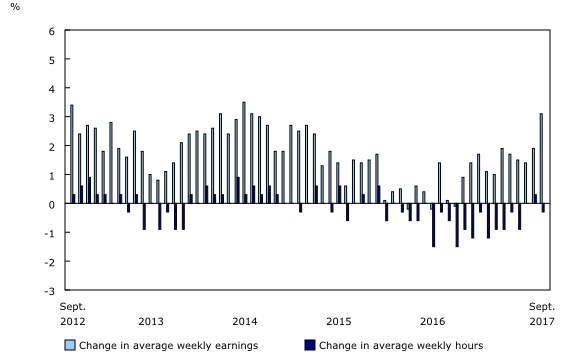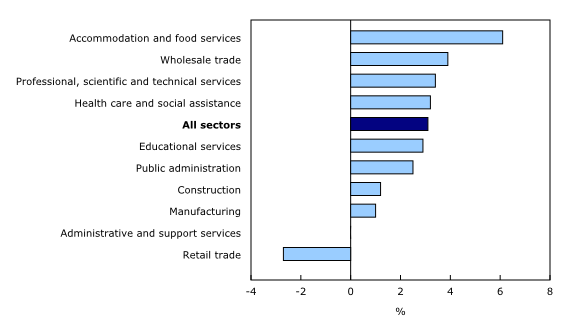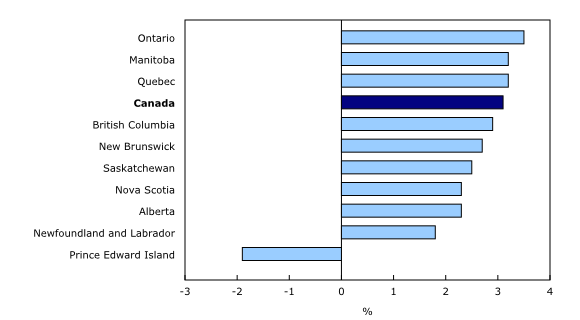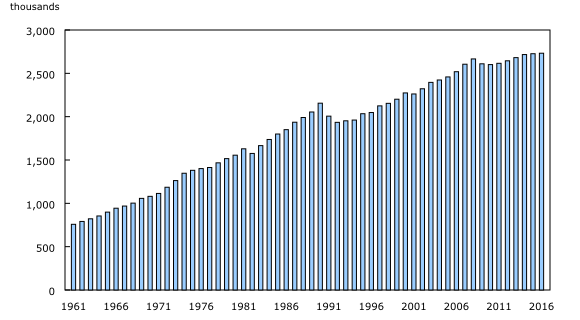Payroll employment, earnings and hours, September 2017
Archived Content
Information identified as archived is provided for reference, research or recordkeeping purposes. It is not subject to the Government of Canada Web Standards and has not been altered or updated since it was archived. Please "contact us" to request a format other than those available.
Released: 2017-11-30
$985.95
September 2017
3.1% 
(12-month change)
$1,034.66
September 2017
1.8% 
(12-month change)
$814.56
September 2017
-1.9% 
(12-month change)
$871.04
September 2017
2.3% 
(12-month change)
$896.83
September 2017
2.7% 
(12-month change)
$910.05
September 2017
3.2% 
(12-month change)
$1,004.80
September 2017
3.5% 
(12-month change)
$915.54
September 2017
3.2% 
(12-month change)
$1,013.87
September 2017
2.5% 
(12-month change)
$1,142.01
September 2017
2.3% 
(12-month change)
$946.95
September 2017
2.9% 
(12-month change)
$1,098.92
September 2017
6.0% 
(12-month change)
$1,427.37
September 2017
2.0% 
(12-month change)
$1,351.80
September 2017
7.7% 
(12-month change)
Average weekly earnings of non-farm payroll employees were $986 in September, up 1.0% from the previous month. Compared with 12 months earlier, earnings increased 3.1%.
In general, changes in weekly earnings reflect a number of factors, including wage growth; changes in the composition of employment by industry, occupation and level of job experience; and average hours worked per week.
Non-farm payroll employees worked an average of 32.7 hours per week in September, little changed from both the previous month and 12 months earlier.
Average weekly earnings by sector
Compared with September 2016, average weekly earnings increased in 6 of the 10 largest industrial sectors, led by accommodation and food services. At the same time, earnings declined in retail trade, and were little changed in construction, manufacturing and administrative and support services.
Average weekly earnings in accommodation and food services increased 6.1% to $394, driven by gains in Ontario, British Columbia and Alberta. Full-service restaurants and limited-service eating places, the largest industry within the sector, contributed the most to the rise.
Average weekly earnings in wholesale trade rose 3.9% to $1,206. The rise in earnings was driven by wholesalers of machinery, equipment and supplies. Ontario, Alberta and British Columbia contributed the most to the earnings increase in this sector.
In professional, scientific and technical services, average earnings were up 3.4% to $1,354. The growth was driven by accounting, tax preparation, bookkeeping and payroll services. Notable increases were observed in Ontario and Quebec.
In health care and social assistance, earnings rose 3.2% to an average of $889 per week. The increase in earnings was most notable in hospitals, as well as in ambulatory health care services. The largest contributors to the growth in this sector were Quebec and Ontario.
For payroll employees in educational services, average weekly earnings were up 2.9% to $1,050. Universities and elementary and secondary schools contributed the most to the year-over-year increase.
Average weekly earnings in public administration grew 2.5% to $1,261, driven by gains in local, municipal and regional public administration. Earnings also increased notably in provincial and territorial public administration. Among the provinces, the largest increase in this sector was observed in Ontario.
In contrast, average weekly earnings in retail trade fell 2.7% to $554, primarily in miscellaneous store retailers and general merchandise stores. The decline was driven by Ontario and Quebec.
Among the smaller industrial sectors, average weekly earnings in finance and insurance rose 8.7% to $1,359, partly due to earnings being at a relatively low point in September 2016. This sector was the largest contributor to the national earnings increase. The growth was spread across most provinces and driven by insurance carriers and credit intermediation.
Average weekly earnings by province
In the 12 months to September, average weekly earnings of non-farm payroll employees increased in nine provinces, led by Ontario, Manitoba and Quebec. Over the same period, earnings decreased in Prince Edward Island.
Average weekly earnings in Ontario were up 3.5% to $1,005. Gains were spread across most industries, notably in finance and insurance; professional, scientific and technical services; and public administration. Most of the increase in the province occurred from July to September 2017.
In Manitoba, average weekly earnings increased 3.2% to $916 per week, driven by transportation and warehousing, as well as finance and insurance.
Average weekly earnings in Quebec were up 3.2% to $910. Health care and social assistance; professional, scientific and technical services; and finance and insurance contributed the most to the rise.
In British Columbia, average weekly earnings rose 2.9% to $947. Earnings were up in most large sectors, with wholesale trade, construction, and educational services contributing the most to the rise.
Earnings in New Brunswick increased 2.7% to $897. Earnings increased notably in health care and social assistance; construction; and professional, scientific and technical services. All of the gains in the province occurred from June to September 2017.
In Saskatchewan, average weekly earnings grew 2.5% to $1,014. Among the large sectors, educational services and manufacturing contributed the most to the rise.
Earnings in Nova Scotia were up 2.3% to $871, led by health care and social assistance as well as finance and insurance. This was the third consecutive month where health care and social assistance was the largest contributor to the earnings increase in the province.
In Alberta, average weekly earnings rose 2.3% to $1,142, driven by employment and earnings gains in the high-paying mining, quarrying, and oil and gas extraction sector. In the 12 months to September, employment in this sector increased notably by 10,200 (+10.5%). There were also earnings gains in other sectors, such as wholesale trade and real estate and rental and leasing.
For payroll employees in Newfoundland and Labrador, average weekly earnings rose 1.8% to $1,035. Health care and social assistance, and professional, scientific and technical services contributed the most to the increase. On the other hand, a decline in construction moderated the overall increase in the province.
In contrast, earnings in Prince Edward Island decreased 1.9% to $815. Manufacturing and retail trade contributed the most to the decline. The overall decrease in the province was tempered by a notable increase in health care and social assistance.
Non-farm payroll employment by sector
The number of non-farm payroll jobs rose by 23,800 (+0.1%) from August. The number of payroll employees increased notably in health care and social assistance; manufacturing; and accommodation and food services. At the same time, the number of payroll jobs declined in retail trade and in administrative and support services.
In the 12 months to September, the number of payroll employees rose by 344,300 (+2.1%), marking a third consecutive year-over-year increase of 2.0% or more. Increases were observed in all of the 10 largest sectors, led by manufacturing (+36,800 or +2.5%) and health care and social assistance (+36,400 or +1.9%). The number of payroll jobs also increased notably in educational services (+36,100 or +2.9%), professional, scientific and technical services (+34,600 or +4.0%), construction (+33,300 or +3.4%) and accommodation and food services (+31,700 or +2.5%).
Spotlight on SEPH and LFS: Health care and social assistance
In the 12 months to September, the pace of employment growth has been similar in both of Statistics Canada's monthly surveys with data on employment: the Survey of Employment, Payrolls and Hours (SEPH) and the Labour Force Survey (LFS).
During this period, for example, both surveys showed similar trends in employment in health care and social assistance. In the SEPH, the number of payroll employees in this sector grew 1.9% and has trended up since April, while average weekly earnings were up 3.2%. At the same time, the LFS showed similar year-over-year growth in total employment in this sector (+2.1%).

In celebration of the country's 150th birthday, Statistics Canada is presenting snapshots from our rich statistical history.
The evolution of employment in wholesale and retail trade
The wholesale and retail trade sector represents a significant component of the service industry in Canada. Wholesalers sell merchandise to other businesses while retailers sell goods in smaller amounts to the public.
In 1911, the wholesale and retail trade sector comprised about 10% of the Canadian workforce, compared with 34% for agriculture and 17% for manufacturing. From the early 1950s, the economy shifted towards the services sector and away from the goods-producing sector. While total employment increased by 28% from 1946 to 1960, the number of individuals working in service-producing industries grew by 72%. In 1961, the wholesale and retail trade sector had 758,000 payroll employees and represented 16% of all payroll employment in Canada.
From 1961 to 1990, the wholesale and retail trade sector continued to grow steadily and increased its share of employment. By 1990, the sector had 2.2 million payroll employees and comprised 19% of employment in Canada. While the number of employees in wholesale and retail trade also increased from 1990 to 2016 (reaching 2.7 million in 2016), the sector's employment share has edged down since the 2008 financial crisis. In 2016, 17% of payroll employees in Canada were employed in the sector, compared to 18% in 2008.
Sources: "One hundred years of labour force." Canadian Social Trends (11-008-X), Table D8-85 in Historical Statistics of Canada (11-516-X), and CANSIM tables 281-0005, 281-0015 and 281-0024.
Sustainable Development Goals
On January 1, 2016, the world officially began implementation of the 2030 Agenda for Sustainable Development—the United Nations' transformative plan of action that addresses urgent global challenges over the next 15 years. The plan is based on 17 specific sustainable development goals.
The Survey of Employment, Payrolls and Hours is an example of how Statistics Canada supports the reporting on the Global Goals for Sustainable Development. This release will be used in helping to measure the following goals:


Note to readers
The Survey of Employment, Payrolls and Hours (SEPH) is produced by a combination of a census of approximately one million payroll deductions provided by the Canada Revenue Agency, and the Business Payrolls Survey, which collects data from a sample of 15,000 establishments. Federal, provincial and territorial public administration data are collected from various administrative records provided by these levels of government. The key objective of the SEPH is to provide a monthly portrait of the level of earnings and the number of jobs and hours worked by detailed industry at the national, provincial and territorial levels.
Estimates of average weekly earnings and hours worked are based on a sample and are therefore subject to sampling variability. This analysis focuses on differences between estimates that are statistically significant at the 68% confidence level. Payroll employment estimates are based on a census of administrative data and are not subject to sampling variability.
Statistics Canada also produces employment estimates from its Labour Force Survey (LFS). The LFS is a monthly household survey, the main objective of which is to divide the working-age population into three mutually exclusive groups: the employed (including the self-employed), the unemployed, and those not in the labour force. This survey is the official source for the unemployment rate, and collects data on the socio-demographic characteristics of all those in the labour market.
As a result of conceptual and methodological differences, estimates of changes from SEPH and LFS do differ from time to time. However, the trends in the data are quite similar. To better understand the conceptual differences between employment measures from the LFS and SEPH, refer to section 8 of the Guide to the Survey of Employment, Payrolls and Hours (72-203-G).
Unless otherwise stated, this release presents seasonally adjusted data, which facilitate comparisons by removing the effects of seasonal variations. For more information on seasonal adjustment, see Seasonally adjusted data – Frequently asked questions.
Non-farm payroll employment data are for all hourly and salaried employees, as well as for the "other employees" category, which includes piece-rate and commission-only employees.
Unless otherwise specified, average weekly hours data are for hourly and salaried employees only and exclude businesses that could not be classified to a North American Industry Classification System (NAICS) code.
All earnings data include overtime pay and exclude businesses that could not be classified to a NAICS code. Earnings data are based on gross taxable payroll before source deductions. Average weekly earnings are derived by dividing total weekly earnings by the number of employees.
With each release, data for the current reference month are subject to revision. Data have been revised for the previous month. Users are encouraged to request and use the most up-to-date data for each month.
Real-time CANSIM tables
Real-time CANSIM tables 281-8023, 281-8026, 281-8047 and 281-8063 will be updated on December 11. For more information, consult the document Real-time CANSIM tables.
Next release
Data on payroll employment, earnings and hours for October will be released on December 20.
Products
A summary table is also available.
Job Vacancy Statistics (5202) from the Survey of Employment, Payrolls and Hours for August are now available in CANSIM.
More information about the concepts and use of the Survey of Employment, Payrolls and Hours and Job Vacancy Statistics is available in the Guide to the Survey of Employment, Payrolls and Hours (72-203-G).
Contact information
For more information, contact us (toll-free: 1-800-263-1136; 514-283-8300; STATCAN.infostats-infostats.STATCAN@canada.ca).
To enquire about the concepts, methods or data quality of this release, contact Dominique Dionne-Simard (613-618-9411; dominique.dionne-simard@canada) or Client Services (toll-free: 1-866-873-8788; statcan.labour-travail.statcan@canada.ca), Labour Statistics Division.
- Date modified:





